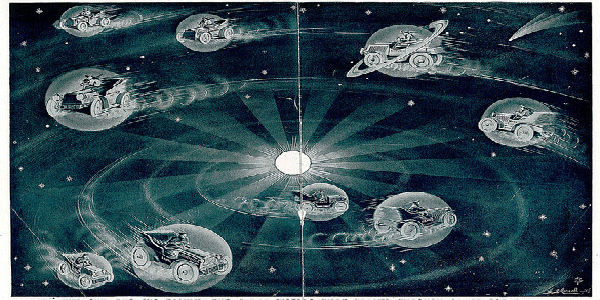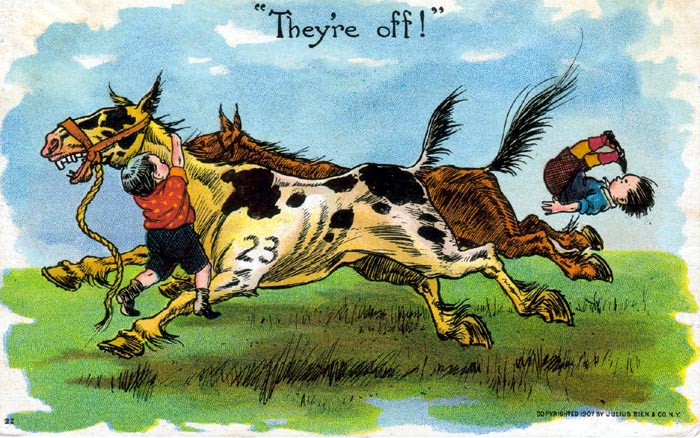By John Townley, January 2013
When
we look at the developments in a nativity, we usually
look at how the progressions are moving across the natal chart, then
how the
transits are moving across the natal chart and the progressed chart.
That’s
because the natal planets remains stationary, the progressed planets
move
slowly, and the transiting planets move faster. That makes us look at
the
relationship of transits and progressions as a series of hits of
transits to
progressions, almost as if the progressions are passively always on the
receiving end.
But
that’s not, in fact, the case. There are often-crucial
periods where the reverse is actually in play or where particular
transiting
and progressed planets may be in a head-to-head race with each other
that can
prolong an ongoing situation for years or even decades.
That’s most well-known
in the case of what’s alternately called “Moon
chasing Saturn” or “Saturn
chasing Moon” (properly the former, as the faster applies to
the slower), it
happens when the progressed Moon (with a 27 ½ year cycle)
locks into aspect
with transiting Saturn (with 29 ½ year cycle).
It’s most noticeable in
nativities with Moon conjunct Saturn, as the poor child has transiting
Saturn
right on top of its progressed Moon for its formative years. Depending
upon the
speed of the Moon and the closeness of the original aspect, it can be
as brief
as three or four years or last into the teens, as the Moon plods along
and
Saturn backs and fills around it in alternating direct and retrograde
motion.
You
get more than one race...
The
same relentlessly-long effect occurs with nativities
with Moon square or opposite Saturn, emphasizing and prolonging the
Saturn
effect well after birth and into childhood. You’ll usually
find it referenced
in relation to the natal chart, but it happens to everybody as a
progression-transit tangle, at least twice in an average lifespan, with
two
succeeding Moon-Saturn involvements, though not always hard aspects.
That’s
because the synodic period of the two is about 420 years, and so
roughly every
35 years they engage one aspect further along (if you’re only
using Ptolemaic
aspects plus semisextile and quincunx, more if you use others). If
you’re born
with Moon near the waxing trine (120 degrees) with Saturn, come age 35,
they
will have worked themselves into a quincunx, and by your late 60s
they’ll be in
opposition. Or, if they were near a waning square (270 degrees) at
birth,
around 35 you’ll be experiencing a supportive waning sextile
(300 degrees) and
finish off with a waning semisextile (330 degrees). And if you live to
105, you
get three versions.
Progessed
Moon chasing
transiting Saturn chasing progressed Moon is the most common race
Of
course, if your natal Moon and Saturn aren’t in aspect to
begin with, you’ll get your first lock-in at a different age,
but they’ll
usually be about 35 years apart. As a rule of thumb, if your natal Moon
is,
say, 20 degrees from its next aspect to Saturn, then your first
Moon-chasing-Saturn aspect will be that aspect and start around age 23
or so,
the next one at the following aspect 35 years later at around 58. But,
because
the speed of the Moon varies so much, it’s best to do it on a
computer, as that
general rule can be as much as a decade off for periods when the
progressed
Moon is very slow or very fast.
More
than that, it’s not just the progressed Moon that
changes speed – so does transiting Saturn. And
we’re not talking yearly
retrograde and direct changes, but average yearly speed, which also
helps
determine its place in the race. At perihelion (most recently in July
2003),
Saturn is cooking along at 13 ¾ degrees a year, whereas at
aphelion it’s doing
only about eleven degrees. So at its fastest, it’s actually
going two degrees a
year faster than a slow progressed Moon (slowest – 11.6/year;
fastest
14.8/year). Put a fast transiting Saturn against a slow progressed Moon
and for
several years it’s actually overtaking the Moon, which then
takes several more
years just to regain its position, and then even a few more to make
progress
ahead. A fast Moon against a slow Saturn, however, virtually zips by in
a
couple of years.
Everyone
gets a taste...
So,
for everybody, the race of Saturn and Moon pulls closer
to a standstill around Saturn’s perihelion, making those
surrounding years
(before and after 2033, 2003, 1973, 1944, for instance) maintain their
current
Saturn-Moon relationships, whereas years surrounding 14 years before
and after
(at Saturn’s aphelion) things change much more rapidly. If
you’re lucky you get
stuck on a supportive aspect (or none at all) rather than a hard
aspect,
depending on how you view Saturn, of course. But look back and find it
in your own experience, it may explain a lot.
Some
sources, notably Celeste Teal, have rather dire things
to say about the hard aspects, and others paint it as a rarity, which
it’s not.
Here are some opinions on the subject ranging from Devore, Teal, and
others,
which themselves have further references:
* From
Kingsley’s blog
about Ben Cousin’s chart
* From Café Astrology, comparing it to Lemony Snicket
*
From Celeste Teal’s site
*
From Devore’s Encyclopedia of Astrology
* From Identifying Planetary Triggers (Teal)

Moon and Saturn aren't the
only transits and progressions trading positions on theplanetary
track...
Although
you usually see it brought up in reference to
individuals, you can also see a mention of it in America’s
national chart in our own Dark
Days
piece a while back. For the Sibly chart, anyway, the
Moon will be chasing Saturn by conjunction right around the period of America’s
first
Pluto return. The opposition happened in the early 1800s, starting some
time
after the War of 1812. And there’s
even more on the specific Moon-Saturn chase, with numerous
personal examples and commentaries, on my blog here.
But
that’s not all!...
Although
the most commonly-noted, that’s not
the only
transit-progression chase
you may run into. In charts with Pluto in Taurus and Gemini (most
recently from
1851-1913), you will find the progressed Sun
locked in with transiting Pluto,
as Pluto at its slowest then moves exactly a degree a
year, the same as the progressed Sun. That’s a lifetime
sentence for many back
then, and Pluto hadn’t even been discovered yet!
Less
lengthy, but worthy note, is progressed Mars locking in with
transiting Pluto
when progressed Mars is fast (up to a degree and a quarter a day at
solar
conjunction) and Pluto is average, which can last for dozens of years,
depending on their relative speeds. The same with Mercury
and Venus,
when
they’re at max speed and Pluto isn’t, but not for
quite for so long.
 Keeping track of racing
transits and progressions can be an unexpected handful -- and a
life-changing tangle!
Keeping track of racing
transits and progressions can be an unexpected handful -- and a
life-changing tangle!
Finally,
on a much shorter scale, progressions may suddenly
overtake transits due to the retrogradation
of the transiting planet as it drops behind and then re-overtakes
a progressed planet.
It usually only lasts a few months, but the
reversal effect of this quickly-exchanged power transfer can be really
pivotal
in reorienting life events, especially when the progressed Moon gets
tangled up
with it as well.
So
all in all, it’s wise to think of transits and
progressions not as active-on-passive events, but as a dynamic tangle
of bodies moving
at varying speeds that can wonderfully expedite or dreadfully delay the
hopes
and expectations of a lifetime...
Not
a
newsletter subscriber already? Subscribe
Free Here!
And
every day, keep in touch with our Astrology In The News section...please
take a look! --
Breaking news from
around the globe, plus articles, reviews, it's all happening there,
changes daily...

